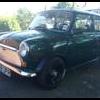The four stroke cycle
A brief history of the four stroke cycle.
The four stroke cycle was patented for the first time in 1854 by Eugenio Barsanti and Felice Matteucci by 1860 two Italians had developed the first prototype. Although a German engineer called Nicolaus Otto was the first to create a functioning four stroke engine that was demonstrated in 1876. This is why they four stroke cycle is often known today as the Otto cycle. Four stroke engines are one of the most common forms of internal combustion engine today.
The four strokes are:
• Intake stroke
• Compression stroke
• Combustion stroke
• Exhaust stroke
The intake stroke - during the intake stroke fuel and air mixture is pulled or (forced) into the cylinder when the intake valve is open. This happens on the downward stroke.
The compression stroke – the intake valve closes and the piston is forced upward by momentum of the fly wheel compressing the fuel and air mixture.
The combustion stroke – the piston reaches the top of the compression stroke the compressed fuel and air mixture is ignited the expansion from the reaction forces the piston down.
The exhaust stroke – the piston reaches the bottom of the combustion stroke the exhaust valve opens and the momentum of the fly wheel pushes the piston upward forcing the exhaust gases and any other deposits out of the cylinder. The piston reaches the top of the exhaust stroke the exhaust valve closes and the cycle can begin all over again.
Meany four stroke engines include more than one cylinder and have different arrangements for the camshaft (duel, overhead, etc.) engines may feature fuel injection systems, turbo chargers and multiple valves any of theses enhancements do- not change the basic operation of the engine using the four stroke cycle or Otto cycle.
The four stroke cycle
A brief history of the four stroke cycle.
The four stroke cycle was patented for the first time in 1854 by Eugenio Barsanti and Felice Matteucci by 1860 two Italians had developed the first prototype. Although a German engineer called Nicolaus Otto was the first to create a functioning four stroke engine that was demonstrated in 1876. This is why they four stroke cycle is often known today as the Otto cycle. Four stroke engines are one of the most common forms of internal combustion engine today.
The four strokes are:
• Intake stroke
• Compression stroke
• Combustion stroke
• Exhaust stroke
The intake stroke - during the intake stroke fuel and air mixture is pulled or (forced) into the cylinder when the intake valve is open. This happens on the downward stroke.
The compression stroke – the intake valve closes and the piston is forced upward by momentum of the fly wheel compressing the fuel and air mixture.
The combustion stroke – the piston reaches the top of the compression stroke the compressed fuel and air mixture is ignited the expansion from the reaction forces the piston down.
The exhaust stroke – the piston reaches the bottom of the combustion stroke the exhaust valve opens and the momentum of the fly wheel pushes the piston upward forcing the exhaust gases and any other deposits out of the cylinder. The piston reaches the top of the exhaust stroke the exhaust valve closes and the cycle can begin all over again.
Meany four stroke engines include more than one cylinder and have different arrangements for the camshaft (duel, overhead, etc.) engines may feature fuel injection systems, turbo chargers and multiple valves any of theses enhancements do- not change the basic operation of the engine using the four stroke cycle or Otto cycle.
The four stroke cycle
A brief history of the four stroke cycle.
The four stroke cycle was patented for the first time in 1854 by Eugenio Barsanti and Felice Matteucci by 1860 two Italians had developed the first prototype. Although a German engineer called Nicolaus Otto was the first to create a functioning four stroke engine that was demonstrated in 1876. This is why they four stroke cycle is often known today as the Otto cycle. Four stroke engines are one of the most common forms of internal combustion engine today.
The four strokes are:
• Intake stroke
• Compression stroke
• Combustion stroke
• Exhaust stroke
The intake stroke - during the intake stroke fuel and air mixture is pulled or (forced) into the cylinder when the intake valve is open. This happens on the downward stroke.
The compression stroke – the intake valve closes and the piston is forced upward by momentum of the fly wheel compressing the fuel and air mixture.
The combustion stroke – the piston reaches the top of the compression stroke the compressed fuel and air mixture is ignited the expansion from the reaction forces the piston down.
The exhaust stroke – the piston reaches the bottom of the combustion stroke the exhaust valve opens and the momentum of the fly wheel pushes the piston upward forcing the exhaust gases and any other deposits out of the cylinder. The piston reaches the top of the exhaust stroke the exhaust valve closes and the cycle can begin all over again.
Meany four stroke engines include more than one cylinder and have different arrangements for the camshaft (duel, overhead, etc.) engines may feature fuel injection systems, turbo chargers and multiple valves any of theses enhancements do- not change the basic operation of the engine using the four stroke cycle or Otto cycle.
Main components of the four stroke cycle
In most internal combustion engines using the four stroke cycle many components are needed to work together in sync for the engine to run properly to understand these components more easily some more information is needed. In a petrol engine exhaust and inlet manifolds (these are like tunnels) and valve ports (inlets and outlets) are needed to provide fuel and air on the intake stroke of the engine, and to expel burned gases on the exhaust stroke. The ports are opened and closed at the proper times by the intake and exhaust valves, which close against the sides of the ports to create a seal. The valves are controlled by the camshaft, a camshaft has lobes on it these lobes are all shaped differently, but resemble an oval on a camshafts lobe sits a lifter. A lifter is cylindrical in shape and pushes up on a push rod, when the lobes are rotating on the camshaft. A push rod is connected to a rocker arm witch then “rocks” down on a spring that is connected to the valve holding it closed when the spring is pushed by the rocker arm the valve opens. This all happens due to the rotation of the camshaft witch is connected via gears to the crankshaft (that the pistons connect to) these are all parts of the four stroke cycle that are needed for the engine to function properly.

















